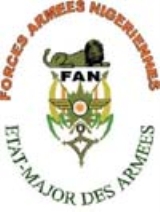
Military of Niger
Unanswered Questions
Encyclopedia
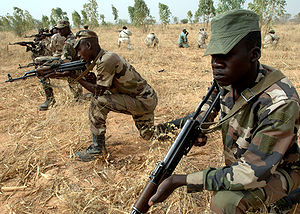
Niger
Niger , officially named the Republic of Niger, is a landlocked country in Western Africa, named after the Niger River. It borders Nigeria and Benin to the south, Burkina Faso and Mali to the west, Algeria and Libya to the north and Chad to the east...
, totaling around 12,000 active personnel and 5,000 reservists. While under civilian political control since 1999, the military has played a major role in Nigerien government, ruling the nation for 21 years of the period from independence in 1960 to the founding of the Fifth Republic in 1999. Military leaders have staged three successful coup d'état
Coup d'état
A coup d'état state, literally: strike/blow of state)—also known as a coup, putsch, and overthrow—is the sudden, extrajudicial deposition of a government, usually by a small group of the existing state establishment—typically the military—to replace the deposed government with another body; either...
s, and there have been several more attempted, as recently as 2002. While never engaging in open warfare with foreign nations, the Nigerien Military has participated in international peacekeeping missions and fought two domestic insurgencies. Since 2007 the armed forces have carried out a campaign against ethnic Tuareg based rebels
Tuareg Rebellion (2007–present)
The Tuareg Rebellion of 2007-2009 was an insurgency that began in February 2007 amongst elements of the Tuareg people living in the Sahara desert regions of northern Mali and Niger. It is only the most recent of a series of insurgencies by formerly nomadic Tuareg populations, which had last...
in the north of the country. The FAN has frequently come under international scrutiny for its human rights record
Human rights in Niger
According to the Republic of Niger's Constitution of 1999, most human rights, as defined by the Universal Declaration of Human Rights, are upheld and protected...
.
History
The Nigerien Armed Forces has been extensively involved in politics since independence, and has been denounced at several points for broad abrogation of human rights and unlawful detentions and killings.History of the FAN prior to 1974
The Armed Forces of Niger were formed according to the 28 July 1960 Decree, with the National Police as a subsection of the military. Initially, units of the Army were created from three companies of French Colonial ForcesFrench Colonial Forces
The French Colonial Forces , commonly called La Coloniale, was a general designation for the military forces that garrisoned in the French colonial empire from the late 17th century until 1960. They were recruited from mainland France or from the French settler and indigenous populations of the...
: Nigerien soldiers officered by Frenchmen who agreed to take joint French-Nigerien citizenship. In 1960 there were only ten African officers in the Nigerien army, all of low rank. President Diori signed legislation to end the employment of expatriate military officers in 1965; some continued to serve until the 1974 coup, when all French military presence was evacuated. As well, the French had maintained until 1974 around 1000 troops of the 4th Régiment Interarmes d'Outre-Mer (Troupes de Marine
Troupes de marine
The or Infanterie de marine, formerly Troupes coloniales, are an arm of the French Army with a colonial heritage. The Troupes de marine have a dedicated overseas service role. Despite their title they have been a part of the Army since 1958...
) with bases at Niamey, Zinder, Bilaro and Agadez. In the late 70s a smaller French force was again based in Niger.
1970 reorganisation
In 1970, the forces were reorganised. The Army was organised into four Infantry battalions, one paratroop company, one light armored company, a Camel corps, and a number of support units. A new Republican Guard of 120 elite troops was created. A 1000-man National Guard was also created in 1970. The Air Forces of 12 aircraft were two squadrons, including a transport squadron. The National Police, also headquartered in Niamey and divided between 500 paramilitary GendarmesGendarmerie
A gendarmerie or gendarmery is a military force charged with police duties among civilian populations. Members of such a force are typically called "gendarmes". The Shorter Oxford English Dictionary describes a gendarme as "a soldier who is employed on police duties" and a "gendarmery, -erie" as...
and 400 civil police, based brigades at Zinder
Zinder
Zinder is the second largest city in Niger, with a population of 170,574 by 2005 was estimated to be over 200,000...
, Maradi, Agadez
Agadez
-Sources:* Aboubacar Adamou. "Agadez et sa région. Contribution à l'étude du Sahel et du Sahara nigériens", Études nigériennes, n°44, , 358 p.* Julien Brachet. Migrations transsahariennes. Vers un désert cosmopolite et morcelé . Paris: Le Croquant, , 324 p. ISBN : 978-2-91496865-2.*. Saudi Aaramco...
, and Tahoua
Tahoua
Tahoua is a city in Niger and the administrative center of the Department of Tahoua and the larger Tahoua Region. It has a population of 99,900 . The city is primarily a market town for the surrounding agricultural area, and a meeting place for the Tuareg people from the north and the Fulani people...
. Apart from policing duties, the National Police were responsible for tax collection until 1974.
1974 military regime
During the military government of Seyni KountchéSeyni Kountché
Seyni Kountché was a Nigerien military officer who led a 1974 coup d'état that deposed the government of Niger's first president, Hamani Diori. He ruled the country as military head of state from 1974 to 1987...
in the late 1970s, the FAN numbered some 2500, 500 of whom were National Police. Headquartered in Niamey
Niamey
-Population:While Niamey's population has grown steadily since independence, the droughts of the early 1970s and 1980s, along with the economic crisis of the early 1980s, have propelled an exodus of rural inhabitants to Niger's largest city...
with bases in the Gamkalle and Yantala suburbs, the military included infantry, one company of paratroops and one company of armor in the mid 1970s. Following the 1974 coup, the Nigerien defense budget accounted for around 9% of government expenditures.
History of military rule
Niger has had four republican constitutions since independence in 1960, but four of its seven presidents have been military leaders, taking power in three coups. Three of the four military rulers of Niger were Chief of Staff of the FAN when they ascended to Head of State, while the current democratically elected President, Tandja MamadouTandja Mamadou
Lieutenant Colonel Mamadou Tandja is a Nigerien politician who was President of Niger from 1999 to 2010. He was President of the National Movement of the Development Society from 1991 to 1999 and unsuccessfully ran as the MNSD's presidential candidate in 1993 and 1996 before being elected to his...
, was an officer who participated in the 1974 coup that brought Seyni Kountché
Seyni Kountché
Seyni Kountché was a Nigerien military officer who led a 1974 coup d'état that deposed the government of Niger's first president, Hamani Diori. He ruled the country as military head of state from 1974 to 1987...
to power and became a member of the Supreme Military Council.
1974–1993 Military government
In 1974 General Seyni KountchéSeyni Kountché
Seyni Kountché was a Nigerien military officer who led a 1974 coup d'état that deposed the government of Niger's first president, Hamani Diori. He ruled the country as military head of state from 1974 to 1987...
overthrew the first president of Niger Hamani Diori
Hamani Diori
Hamani Diori was the first President of the Republic of Niger. He was appointed to that office in 1960, when Niger gained independence.- Youth :...
. The government that followed, while plagued by coup attempts of its own, survived until 1993. While a period of relative prosperity, the military government of the period allowed little free expression and engaged in arbitrary imprisonment and killing. The first presidential elections took place in 1993 (33 years after independence), and the first municipal elections only took place in 2007.
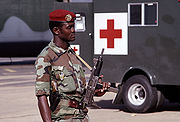
1985–1990 insurgency
In NigerNiger
Niger , officially named the Republic of Niger, is a landlocked country in Western Africa, named after the Niger River. It borders Nigeria and Benin to the south, Burkina Faso and Mali to the west, Algeria and Libya to the north and Chad to the east...
's far north, drought, economic crisis, and the central government's political weakness came to a head in 1985. That year, a number of Tuareg in Libya
Libya
Libya is an African country in the Maghreb region of North Africa bordered by the Mediterranean Sea to the north, Egypt to the east, Sudan to the southeast, Chad and Niger to the south, and Algeria and Tunisia to the west....
formed a political opposition group called the Popular Front for the Liberation of Niger (FPLN). An armed attack by FPLN members in Tabardene sparked the closing of the borders with Libya and Algeria, and the resettlement of thousands of Tuareg and other nomads away from the area. As economic and political conditions worsened, grievances grew. When aid promised by Ali Saïbou
Ali Saibou
Ali Saibou was the third President of Niger from 1987 to 1993 succeeding the deceased Seyni Kountché.A member of the Djerma people, he was born in Dingajibanda, a village in the Ouallam arrondissement. Although from Kountché's home village, Saibou is not a cousin...
's government to Tuareg returning from Algeria
Algeria
Algeria , officially the People's Democratic Republic of Algeria , also formally referred to as the Democratic and Popular Republic of Algeria, is a country in the Maghreb region of Northwest Africa with Algiers as its capital.In terms of land area, it is the largest country in Africa and the Arab...
failed to materialise, some Tuareg attacked a police station
Police station
A police station or station house is a building which serves to accommodate police officers and other members of staff. These buildings often contain offices and accommodation for personnel and vehicles, along with locker rooms, temporary holding cells and interview/interrogation rooms.- Facilities...
in Tchin-Tabaradene in May 1990, leading to the death of 31, including 25 of the attackers. Initially the rebel's main demand was for the right for their children to learn Tamashek at school, but this soon escalated to a demand for autonomy. Later in May 1990, the Nigerien Military responded by arresting, torturing, and killing several hundred Tuareg civilians in Tchintabaraden, Gharo
Gharo
Gharo is a city in Thatta District, Sindh, Pakistan. The Gharo Wind Power Plant is being built in Gharo.It has large bazar for shopping of local commnunities...
and In-Gall
In-Gall
In-Gall is a town in the Agadez Region, Tchirozerine Department of northeast Niger, with a year-round population of less than 500...
. This became known as the Tchintabaraden massacre. Tuareg outrage sparked the creation of two armed insurgent groups: the Front for the Liberation of Aïr and Azaouak and the Front for the Liberation of Tamoust. The ongoing 1990s Tuareg Insurgency
Tuareg Rebellion
The Tuareg Rebellion was an uprising by various Tuareg groups in Niger and Mali with the aim of achieving autonomy or forming their own nation-state. The insurgency occurred in a period following the regional famine of the 1980s and subsequent refugee crisis, and a time of generalised political...
only ended in 1995.
1996 and 1999 military coups
In 1996 a former officer under Kountché and the then Army Chief of Staff, Ibrahim Baré MaïnassaraIbrahim Baré Maïnassara
Colonel Ibrahim Baré Maïnassara was a military officer in the West African country of Niger who seized power in a January 1996 coup d'état and ruled the country until his assassination during the military coup of April 1999....
, staged his own coup, placing the military again in power. During the Maïnassara regime, human rights abuses were reported by foreign NGOs, including the discovery of 150 dead bodies in a mass grave at Boultoungoure, thought to be Toubou
Toubou
The Tubu are an ethnic group that live mainly in northern Chad, but also in Libya, Niger and Sudan....
rebels. In April 1999, another coup by Army officers began with the murder of Maïnassara at Hamani Diori Airport by his own guards: an act for which no one has ever been prosecuted. Major Daouda Mallam Wanke, commander of the Niamey based military region and the head of the Republican Guard assumed power, but returned the nation to civilian rule within the year. The 1999 constitution followed, and in 2004 Mamadou Tandja was elected to his second five-year presidential term in an election that international observers deemed generally free and fair. Despite this, there has been one recent large military rising against elected government which took place in the Diffa Region in 2002. Three garrisons rose against the government, and scattered units rebelled in the capital: all were eventually put down by loyal units, and mass arrests of military personnel followed.
Continued political involvement
The involvement of the military in politics has historically led to regular, if infrequent, arbitrary arrest and detention, use of excessive force, torture, and extra-judicial killingExtra-judicial killing
An extrajudicial killing is the killing of a person by governmental authorities without the sanction of any judicial proceeding or legal process. Extrajudicial punishments are by their nature unlawful, since they bypass the due process of the legal jurisdiction in which they occur...
by security forces and police. The judiciary has historically suffered from poor jail and prison conditions, prolonged pretrial detention, and executive interference in the judiciary. While all these have improved dramatically since the return to civilian rule, international human rights organizations continue to report sporadic incidents of all these abuses. Post-1999 there has been a marked improvement of civilian control of security forces, with the United States State Department contending every year since 2001 that the military was under civilian control.
There have been three blanket states of emergency declared since 1999, the longest beginning in August 2007 for the entire Agadez Region, and renewed in November 2007. These states of emergency essentially remove all rights to protest, gathering and free movement, and are enforced by the Military, including the Gendarmarie. The 2007–2008 state of emergency in Agadez allows detention without charge or trial. Amnesty International has charged the military with widespread detention and at least 16 military killings of unarmed civilians.
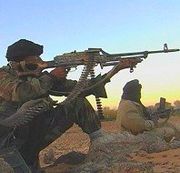
Recent conflicts
The Nigerien Armed Forces were involved from 2007 to 2010 in an insurgency in the north of the country, labeled the Second Tuareg Rebellion. A previously unknown group, the Mouvement des Nigeriens pour la JusticeNiger Movement for Justice
The Nigerien's Movement for Justice is a largely Tuareg ethnic, northern Niger based militant group...
(MNJ), emerged in February 2007. The predominantly Tuareg group has issued a number of demands, mainly related to development in the north. It has attacked military and other facilities and laid landmines in the north. The resulting insecurity has devastated Niger's tourist industry and deterred investment in mining and oil. The government has labeled the MNJ criminals and traffickers, and refuses to negotiate with the group until it disarms. As of July 2008, some 100 to 160 Nigerien troops have been killed in the ongoing conflict.
General staff
The military forces are governed by a Military General Staff (composed of the heads—Chef d'État-Majors of each service arm), the Chief of the Defense Staff (Chef d'État-Major des Armées), and a civilian Minister of Defense, who reports to the President of Niger. This system closely resembles the French Armed forces modelChief of the Defence Staff (France)
The Chief of the Defence Staff is the chief of staff of the Military of France. The position is currently held by Admiral Édouard Guillaud.- Functions :The Chief of the Defence Staff has two roles:...
. A Chef d'État-Major and an Adjunct serves each of the military arms (Army, Air, National Guard) as well as commanders of each of the seven regional Military Zones. The President also appoints a Chef d'Etat Major Particulier and a Commandant of the Garde Présidentielle who answer directly to the President but sit on the General Staff.
Chiefs of Staff
With advent of the 7th Republic in 2011, Général de division Seyni Garba was named Chief of Staff, serving under Minister of Defense of Niger Karidio Mahamadou. He succeeded by General Salou Souleymane, put in place after the coup that toppled Mamadou Tandja in February 2010. General Boureima Moumouni was Chief of the Defense Staff of the FAN from 2000, and was a prominent member of the junta which staged the April 1999 coup.From independence through the 1960s Major Mainassara Damba was Chief of the Defence Staff, followed by Major Bala Arabe (1970–73), Major Seyni Kountché
Seyni Kountché
Seyni Kountché was a Nigerien military officer who led a 1974 coup d'état that deposed the government of Niger's first president, Hamani Diori. He ruled the country as military head of state from 1974 to 1987...
(1973–75), and Major Ali Seibou (1975–1987). Major Ibrahim Baré Maïnassara
Ibrahim Baré Maïnassara
Colonel Ibrahim Baré Maïnassara was a military officer in the West African country of Niger who seized power in a January 1996 coup d'état and ruled the country until his assassination during the military coup of April 1999....
served as Chief of the Defence Staff from 1995, before seizing power in 1996. He placed Colonel Moussa Moumouni Djermakoye
Moussa Moumouni Djermakoye
Moussa Moumouni Djermakoye is a Nigerien politician who has been President of the Nigerien Alliance for Democracy and Progress since 2010. As a high ranking army officer, he was Army Chief of Staff for a time and also briefly served as Minister of National Defense in 1999 as part of a...
as his Chief of the Defence Staff, one of the men later implicated in the coup which in 1999 killed Maïnassara.
Army
The Army is made up around 8,000 troops (2003), which includes draftees, around 4,000 members of the elite Garde Republicaine (folded with the FNIS into the new GNN in 2010) and career soldiers. There is an additional 5,000-member reserve force of part-time National Guard forces. Units include logistics, motorized infantry, airborne infantry, artillery and armoured companies. There is a total of 10 pure motorized infantry battalions, three of which are Saharan. The other battalions are mixed, or inter arms like the ones in Niamey, Zinder, Tahoua and Madawela. Each of these battalions comprises a logistics and engineering or genie sapeur company, an infantry company, be it airborne or land, an armoured squadron and an artillery company. The Armed forces are commanded from the Joint Chiefs in Niamey through appointed commandeers of each of the seven "Defense Zones", which largely overlap each of the civilian Regions of NigerRegions of Niger
||Niger is divided into 7 Regions . Each department's capital is the same as its name.-Current regions:*Agadez Region*Diffa Region*Dosso Region*Maradi Region*Tahoua Region*Tillabéri Region*Zinder Region...
.
Special training sites include the Ecole de Formation des Forces Armées Nigériennes (EFOFAN) National Officers Training School and The Paramedical Personnel Training School (EPPAN), both based at Camp Tondibiah in the southern suburbs of Niamey.
Equipment
- Panhard AMLPanhard AML-Former Operators:: unknown number of AML-60s and AML-90s in service between 1960-1975.: 34 Eland 90s and Eland 60s in service with the Rhodesian Security Forces in 1979, passed on to successor state.-Trivia:...
-90 4x4 90mm gun ARV-125 - Panhard M3Panhard M3The Panhard M3 VTT , armoured personnel carrier was designed as a private venture with the first prototype completed in 1969. The prototype had a single door in each side of the hull and twin doors in the hull rear...
4x4 APC -22 - Panhard VBLVBLThe Panhard Véhicule Blindé Léger is a wheeled 4x4 all-terrain vehicle offered in various configurations. It was designed to combine the agility of the Peugeot VLTT liaison vehicle with adequate protection against small arms fire, artillery fragments, mines and NBC weapons...
4x4 APC-7 - IMI-Uzi SMG
- AKMAKMThe AKM is a 7.62mm assault rifle designed by Mikhail Kalashnikov. It is an upgraded version of the AK-47 rifle and was developed in the 1950s....
AR - FN-MAG 60-00 LMG
 Belgium
Belgium - RPG-7RPG-7The RPG-7 is a widely-produced, portable, unguided, shoulder-launched, anti-tank rocket-propelled grenade launcher. Originally the RPG-7 and its predecessor, the RPG-2, were designed by the Soviet Union, and now manufactured by the Bazalt company...
Light ATRL - M2 Browning machine gun HB HMG
- Brandt mle 27/31Brandt mle 27/31The Brandt mle 27/31 mortar was a regulation weapon of the French army during the Second World War. Designed by Edgar Brandt it was copied by numerous countries.-Description:...
medium mortar - M14M14M14, M-14, or M.14 may refer to:* M-14 , a road connecting Ann Arbor and Detroit* M14 * M14 mine, a United States anti-personnel landmine* AN/M14 incendiary grenade, a United States incendiary grenade...
assault rifle
Niger Air Force

The Niger Air Force (L'armée de l'air) replaced the previous military air wing (Groupement aérien national GAN) 16 December 2003. While long a transport and logistic service for the military and government, it's civilian transport mission was spun off as the Escadrille Nationale du Niger
Escadrille Nationale du Niger
Escadrille Nationale du Niger is the governmental airline of Niger based in Niamey. Its main base is Diori Hamani International Airport.- Fleet :The Escadrille Nationale du Niger fleet includes the following aircraft :* 1 Boeing 737-200...
, operator of the Presidential aircraft Mt. Bagzane. The Air Forces have since begun to expand their missions, acquiring light reconnaissance aircraft for both internal security and ground support missions. The Air Force is based at "Air Base 101"(base aérienne 101) which abuts Diori Hamani International Airport
Diori Hamani International Airport
Diori Hamani International Airport is an airport in Niamey, the capital of Niger. It is located in the south eastern suburbs of the city, along the Route Nationale 1, the major highway linking Niamey with the east of the nation. The airport complex also includes the major base for the Armed Forces...
in Niamey
Niamey
-Population:While Niamey's population has grown steadily since independence, the droughts of the early 1970s and 1980s, along with the economic crisis of the early 1980s, have propelled an exodus of rural inhabitants to Niger's largest city...
.
It is structured as follows:
- Command unit, led by Chef d'Etat major de l'Armée de l'Air, le lieutenant-colonel Boulama Issa Zana Boukar Dipchiarima (2011 -- ) (chef d'etat major) answerable to the Joint Chief and the Minister of Defense;
- Operation units (opérations, escadrons);
- Technical units;
- Generalised staff;
- One company of infantry (compagnie de fusiliers).
Resources (2003):
just less than 300 persons (41 officers of which 25 are pilots, 95 NCOs, 150 enlisted).
Current air force equipment (2008)
! style="text-align: left; background: #aacccc;"|Aircraft! style="text-align: left; background: #aacccc;"|Origin
! style="text-align: left; background: #aacccc;"|Type
! style="text-align: left; background: #aacccc;"|Versions
! style="text-align: left; background: #aacccc;"|In service
! style="text-align: left; background: #aacccc;"|Notes
|-----
| Boeing 737
Boeing 737
The Boeing 737 is a short- to medium-range, twin-engine narrow-body jet airliner. Originally developed as a shorter, lower-cost twin-engine airliner derived from Boeing's 707 and 727, the 737 has developed into a family of nine passenger models with a capacity of 85 to 215 passengers...
|
 United States
United States| VIP transport
|
| 1
|
|-----
| Lockheed C-130 Hercules
|
 United States
United States| Heavy transport
|
| 1
| 2 delivered.
|-----
| Dornier Do 228
Dornier Do 228
The Dornier 228 is a twin-turboprop STOL utility aircraft, manufactured by Dornier GmbH from 1981 until 1998. In 1983, Hindustan Aeronautics bought a production licence and manufactures the 228 for the Asian market sphere. Approximately 270 Do 228 were built at Oberpfaffenhofen, Germany and...
|
 Germany
Germany| Medium transport
|
| 1
| 14 passengers or 2 tonnes of freight. 4 delivered.
|-----
| Dornier Do 28
Dornier Do 28
The Dornier Do 28 Skyservant is a twin-engine STOL utility aircraft, manufactured by Dornier Flugzeugbau GmbH. It served with the Luftwaffe and Marineflieger and other air forces around the world in the communications and utility role....
|
 Germany
Germany| Light transport
|
| 1
| 8 passengers
|-----
| ULM Tétras
|
 Early Modern France
Early Modern France| reconnaissance
|
| 4
| Rebel forces claim one of these was destroyed 4 May 2008. Government claims accidental crash.
|-----
| Mil Mi-17 Hip-H
Mil Mi-17
The Mil Mi-17 is a Russian helicopter currently in production at two factories in Kazan and Ulan-Ude...
|
 Soviet Union
Soviet Union| medium transport helicopter
|
| 2
|
|-----
| Mil Mi-24
Mil Mi-24
The Mil Mi-24 is a large helicopter gunship and attack helicopter and low-capacity troop transport with room for 8 passengers. It is produced by Mil Moscow Helicopter Plant and operated since 1972 by the Soviet Air Force, its successors, and by over thirty other nations.In NATO circles the export...
|
 Russia
Russia| Heavy attack helicopter
|
| 2
| Put into operation in 2007 and destroyed by rebel forces 27 June 2008. There is no government confirmation of this.
|-----
Police
The General Directorate of National PoliceNational Police (Niger)
The National police of Niger are one of two Police forces, previously under the control of the Armed Forces of Niger, but following the Constitution of 1999, come under the control of the Ministry of the Interior...
, headquartered in Niamey was until the 1999 Constitution under the command of the Armed Forces and Ministry of Defense. Today, only the National Gendarmerie reports to the Ministry of Defense, with the National Police and its Para-Military Arm—FNIS—moved to the Nigerien Interior Ministry. The National Gendarmerie
Gendarmerie Nationale (Niger)
The Gendarmerie Nationale is the national paramilitary police force of Niger. One of two paramilitary police units of the nation, the Gendarmerie Nationale is modeled on the Gendarmerie of former colonial power, France...
(modeled on the French Gendarmerie
Gendarmerie
A gendarmerie or gendarmery is a military force charged with police duties among civilian populations. Members of such a force are typically called "gendarmes". The Shorter Oxford English Dictionary describes a gendarme as "a soldier who is employed on police duties" and a "gendarmery, -erie" as...
) and the National Forces for Intervention and Security (FNIS) (Forces nigerienne d'internale securite- FNIS) count a combined 3,700 member paramilitary police force. The FNIS, along with some special units of the Gendarmerie, are armed and trained in military fashion, similar to the Internal Troops
Internal Troops
The Internal Troops, full name Internal Troops of the Ministry for Internal Affairs ; alternatively translated as "Interior " is a paramilitary gendarmerie-like force in the now-defunct Soviet Union and its successor countries, particularly, in Russia, Ukraine, Georgia and Azerbaijan...
of the nations of the former Soviet Union. The Gendarmerie has law enforcement jurisdiction outside the Urban Communes
Communes of Niger
The Departments of Niger are subdivided into communes. As of 2005, in the seven Regions and one Capital Area, there were 36 départements, divided into 265 communes, 122 cantons and 81 groupements...
of Niger, while the National police patrols towns. Special internal security operations may be carried out by the Military, the FNIS, the Gendarmerie, or whatever forces tasked by the Government of Niger.
Cultural sponsorships
The Army, FNIS and the National Football Police sponsor semi-professional football clubs, ASFANASFAN
ASFAN is a Nigerien football club based in Niamey and operated by the Nigerien Armed Forces . They play at the stade du camp Bagagi Iya, a small stadium in one of Niamey's military bases, although larger matches are played at the stade Général Seyni Kountché...
, AS-FNIS
AS-FNIS
AS GNN is a Nigerien football club based in Niamey and sponsored by the National Forces for Intervention and Security .In 2011 the club was renamed from AS-FNIS to AS GNN.-Achievements:...
and AS Police, which play in the Niger Premier League
Niger Premier League
The Niger Premier League is the highest division in football in Niger. The league's first year of operation was 1966.-Structure:...
.
Professionalisation
The Armed Forces—which includes the National Gendarmerie—have undergone a series of structural changes aimed at professionalisation of the ranks and the retaining of more skilled recruits. Greater emphasis on recruiting officers and NCOs, lessening recruitment of lower ranks, and more training required between promotions have been instituted. Annual recruitment for the Army and the Gendarmerie now stands at one thousand each.Foreign missions
In 1991, Niger sent a 400-man military contingent to join the American-led allied forces against IraqIraq
Iraq ; officially the Republic of Iraq is a country in Western Asia spanning most of the northwestern end of the Zagros mountain range, the eastern part of the Syrian Desert and the northern part of the Arabian Desert....
during the Gulf War
Gulf War
The Persian Gulf War , commonly referred to as simply the Gulf War, was a war waged by a U.N.-authorized coalition force from 34 nations led by the United States, against Iraq in response to Iraq's invasion and annexation of Kuwait.The war is also known under other names, such as the First Gulf...
. Niger provides a battalion of peace-keeping forces to the UN Mission in Côte d'Ivoire
Côte d'Ivoire
The Republic of Côte d'Ivoire or Ivory Coast is a country in West Africa. It has an area of , and borders the countries Liberia, Guinea, Mali, Burkina Faso and Ghana; its southern boundary is along the Gulf of Guinea. The country's population was 15,366,672 in 1998 and was estimated to be...
.
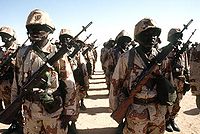
- ECOMOG: LiberiaLiberiaLiberia , officially the Republic of Liberia, is a country in West Africa. It is bordered by Sierra Leone on the west, Guinea on the north and Côte d'Ivoire on the east. Liberia's coastline is composed of mostly mangrove forests while the more sparsely populated inland consists of forests that open...
, Guinée-Bissau; - African UnionAfrican UnionThe African Union is a union consisting of 54 African states. The only all-African state not in the AU is Morocco. Established on 9 July 2002, the AU was formed as a successor to the Organisation of African Unity...
: BurundiBurundiBurundi , officially the Republic of Burundi , is a landlocked country in the Great Lakes region of Eastern Africa bordered by Rwanda to the north, Tanzania to the east and south, and the Democratic Republic of the Congo to the west. Its capital is Bujumbura...
(MIOB), ComorosComorosThe Comoros , officially the Union of the Comoros is an archipelago island nation in the Indian Ocean, located off the eastern coast of Africa, on the northern end of the Mozambique Channel, between northeastern Mozambique and northwestern Madagascar...
(MIOC); - United NationsUnited NationsThe United Nations is an international organization whose stated aims are facilitating cooperation in international law, international security, economic development, social progress, human rights, and achievement of world peace...
: Saudi ArabiaSaudi ArabiaThe Kingdom of Saudi Arabia , commonly known in British English as Saudi Arabia and in Arabic as as-Sa‘ūdiyyah , is the largest state in Western Asia by land area, constituting the bulk of the Arabian Peninsula, and the second-largest in the Arab World...
(Iraq War), RwandaRwandaRwanda or , officially the Republic of Rwanda , is a country in central and eastern Africa with a population of approximately 11.4 million . Rwanda is located a few degrees south of the Equator, and is bordered by Uganda, Tanzania, Burundi and the Democratic Republic of the Congo...
(MINURCA), Democratic Republic of Congo (MONUC);
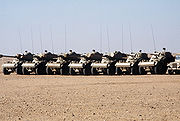
Budget and foreign aid
NigerNiger
Niger , officially named the Republic of Niger, is a landlocked country in Western Africa, named after the Niger River. It borders Nigeria and Benin to the south, Burkina Faso and Mali to the west, Algeria and Libya to the north and Chad to the east...
's defense budget is modest, accounting for about 1.6% of government expenditures. France provides the largest share of military assistance to Niger. Morocco
Morocco
Morocco , officially the Kingdom of Morocco , is a country located in North Africa. It has a population of more than 32 million and an area of 710,850 km², and also primarily administers the disputed region of the Western Sahara...
, Algeria
Algeria
Algeria , officially the People's Democratic Republic of Algeria , also formally referred to as the Democratic and Popular Republic of Algeria, is a country in the Maghreb region of Northwest Africa with Algiers as its capital.In terms of land area, it is the largest country in Africa and the Arab...
, the People's Republic of China
People's Republic of China
China , officially the People's Republic of China , is the most populous country in the world, with over 1.3 billion citizens. Located in East Asia, the country covers approximately 9.6 million square kilometres...
, and Libya
Libya
Libya is an African country in the Maghreb region of North Africa bordered by the Mediterranean Sea to the north, Egypt to the east, Sudan to the southeast, Chad and Niger to the south, and Algeria and Tunisia to the west....
also provide military assistance. Approximately 18 French military advisers are in Niger. Many Nigerien military personnel receive training in France, and the Nigerien Armed Forces are equipped mainly with materiel either given by or purchased in France. United States assistance has focused on training pilots and aviation support personnel, professional military education for staff officers, and initial specialty training for junior officers. A small foreign military assistance program was initiated in 1983 and a U.S. Defense Attaché
Defense Attaché System
The Defense Attaché System is a part of the Defense Intelligence Agency in the United States that provides military and civilian attachés to foreign governments.- History :...
office opened in June 1985. After being converted to a Security Assistance Office in 1987, it was subsequently closed in 1996, following a coup d'état. A U.S. Defense Attaché office reopened in July 2000.
The United States provided transportation and logistical assistance to Nigerien troops deployed to Côte d'Ivoire in 2003.
Additionally, the US provided initial equipment training on vehicles and communications gear to a company of Nigerien soldiers as part of the Department of State Pan Sahel Initiative
Pan Sahel Initiative
The Pan-Sahel Initiative, according to a November 7, 2002, by the Office of Counterterrorism, U.S. Department of State, was "a State-led effort to assist Mali, Niger, Chad, and Mauritania in detecting and responding to suspicious movement of people and goods across and within their borders through...
. Military to military cooperation continues via the Trans-Saharan Counter Terrorism Partnership and other initiatives. EUCOM contributes funds for humanitarian assistance construction throughout the country. In 2007, a congressional waiver was granted which allows the Niger military to participate in the International Military Education and Training
International Military Education and Training
International Military Education and Training is the title of a United States security assistance program, a type of student exchange program. The policies underlying this program are directed by the United States Department of State's Bureau of Political-Military Affairs and the constituent...
(IMET) program, managed by the Defense Attaché Office. This program funded $170,000 in training in 2007.

